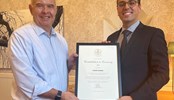New study examines the foreign influences shaping Sweden’s economy
As the world is grappling with escalating inflation and volatile markets, central banks across the globe are responding by raising interest rates. In less than two years, the US Federal Reserve, which oversees the world’s largest economy, has hiked its interest rate by 500 basis points. Such monetary decisions don’t merely reverberate within Wall Street; their impact resonates globally, and Sweden Sweden is no exception to its reach.
"The sheer magnitude of external influences on Sweden’s economy is both fascinating and concerning," says Lina Thomas, a doctoral researcher affiliated with the Stockholm School of Economics and Harvard University. "Given that 73% of Sweden's economic fluctuations can be traced back to global shocks, it's paramount for us to recognize and strategically navigate these international influences." Among the global influencers, the US and the Euro area stand as primary drivers.
Even minor adjustments in US interest rates can hamper Sweden's growth trajectory, Lina Thomas points out. It's not merely the direct interplay between the US and Sweden; it's the global cascade of reactions that follow, affecting other countries and markets closely linked with Sweden.
“It's crucial to understand that for Sweden, the direct US actions are only part of the equation; the global economic domino they generate is the real challenge,” Lina Thomas says.
She emphasizes the importance of policymakers closely tracking economic developments in major world economies.The Riksbank has already taken steps to incorporate these insights into its policymaking with the development of the MAJA model, which explicitly considers the impacts of global economic developments.
Read the complete study: Global Currents, Local Waves: The Foreign Influences Shaping Sweden’s Economy
For more information, please contact:
Lina Thomas
Doctoral Researcher
Stockholm School of Economics and Harvard University
Email: lina.thomas@phdstudent.hhs.se




